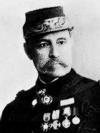- Díaz, Porfirio
-
born Sept. 15, 1830, Oaxaca, Mex.died July 2, 1915, Paris, Fr.Soldier and president of Mexico (1877–80, 1884–1911).After training for the priesthood, he pursued a military career instead. When peace was restored to Mexico under Benito Juárez, Díaz resigned his command, but he soon became dissatisfied with the government. After leading two revolts, he was elected president in 1877. He succeeded in bolstering the export economy through foreign investment, while leading in the spirit of a caudillo, suppressing opposition, rigging elections, and using patronage to win the cooperation of various groups. The Mexican Revolution was launched in 1910 to end his dictatorship and reverse his policies. See also Francisco Madero, La Reforma.
 Porfirio Díaz.Library of Congress, Washington, D.C.
Porfirio Díaz.Library of Congress, Washington, D.C.* * *
▪ president of Mexicoborn September 15, 1830, Oaxaca, Mexicodied July 2, 1915, Paris, Francesoldier and president of Mexico (1877–80, 1884–1911), who established a strong centralized state that he held under firm control for more than three decades.A mestizo (part Indian), Díaz was of humble origin. He began training for the priesthood at age 15, but upon the outbreak of war with the United States (1846–48) he joined the army. An illustrious military career followed, including service in the War of the Reform (1857–60) and the struggle against the French in 1861–67, when Maximilian became emperor. Earlier (1849), Díaz studied law with the encouragement of the Liberal Benito Juárez (Juárez, Benito), who first became president in 1858.Díaz resigned his command and went back to Oaxaca when peace was restored but soon became dissatisfied with the Juárez administration. He led an unsuccessful protest against the 1871 reelection of Juárez, who died the following year. Díaz continued his protests in an unsuccessful revolt against President Sebastían Lerdo de Tejada (Lerdo de Tejada, Sebastián) in 1876, after which he fled to the United States. Six months later, however, he returned and defeated the government forces at the Battle of Tecoac (November 1876), and in May 1877 he was formally elected president.During his first four years in office, Díaz began a slow process of consolidation of power and built up a strong political machine. His administration achieved a few public improvements but was more noted for its suppression of revolts. Having opposed Lerdo's reelection, he decided not to run for another term himself but handpicked his successor, General Manuel González (González, Manuel), who also soon dissatisfied him. Therefore, in 1884, Díaz ran for the presidency again and was elected.Over the course of the next 26 years Díaz produced an orderly and systematic government with a military spirit. He succeeded in destroying local and regional leadership until the majority of public employees answered directly to him. Even the legislature was composed of his friends, and the press was muffled. He also maintained tight control over the courts.Díaz secured his power by catering to the needs of separate groups and playing off one interest against another. He won the mestizos' support by supplying them with political jobs. The privileged Creole classes were cooperative in return for the government's noninterference in their haciendas and for positions of honour in the administration. The Roman Catholic church maintained a policy of noninvolvement in return for a certain degree of freedom. The Indians, who formed a full third of the population, were ignored.When Díaz came to power, the Mexican government was in debt and had very little cash reserves; therefore, he enthusiastically encouraged investment by foreigners. Conditions were made so advantageous to the suppliers of capital that Mexican industries and workers alike suffered. Díaz was no economist, but his two principal advisers, Matías Romero and José Y. Limantour (after 1893), were responsible for the influx of foreigners to build railroads and bridges, to dig mines, and to irrigate fields. Mexico's new wealth, however, was not distributed throughout the country; most of the profits went abroad or stayed in the hands of a very few wealthy Mexicans. By 1910 the economy had declined and national revenues were shrinking, which necessitated borrowing. With wages decreasing, strikes were frequent. Agricultural workers were faced with extreme poverty and debt peonage.On February 17, 1908, in an interview with a reporter for Pearson's Magazine, Díaz announced his retirement. Immediately opposition and progovernment groups began to scramble to find suitable presidential candidates. Then, as plans were being formalized, Díaz decided not to retire but to allow Francisco Madero (Madero, Francisco), an aristocratic but democratically inclined reformer, to run against him. Madero lost the election, as was expected; but when he resorted to a military revolution, the government proved surprisingly weak and collapsed. Díaz resigned office on May 25, 1911, and went into exile.Additional ReadingPaul H. Garner, Porfirio Díaz (2001).* * *
Universalium. 2010.
